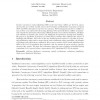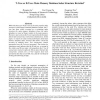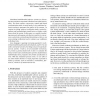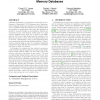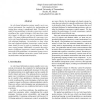HT
1993
ACM
14 years 3 months ago
1993
ACM
Traditional concurrency control techniques for database systems (transaction management based on locking protocols) have been successful in many multiuser settings, but these tech...
RTSS
1994
IEEE
14 years 3 months ago
1994
IEEE
Various concurrency control algorithms di er in the time when con icts are detected, and in the way they are resolved. In that respect, the Pessimistic and Optimistic Concurrency ...
CSCW
1996
ACM
14 years 3 months ago
1996
ACM
Concurrency control and group undo are important issues in the design of groupware, especially for interactive group editors. We present an improved versionofanexistingdistributed...
ADBIS
1997
Springer
14 years 3 months ago
1997
Springer
In this paper we consider real-time concurrency control for the nested transaction model. We analyze problems that have pure optimistic and pessimistic approaches. As the solution...
POS
1998
Springer
14 years 3 months ago
1998
Springer
Concurrency is a central pillar of the Java programming language, is implicit in the transactional model of computation adopted by most persistent systems, and has been widely stu...
IPPS
1999
IEEE
14 years 3 months ago
1999
IEEE
The availability of high speed networks and improved microprocessor performance have made it possible to build inexpensive cluster of workstations as an appealing platform for par...
ADC
2000
Springer
14 years 3 months ago
2000
Springer
While the B-tree (or the B+ -tree) is the most popular index structure in disk-based relational database systems, the Ttree has been widely accepted as a promising index structure...
HICSS
2000
IEEE
14 years 3 months ago
2000
IEEE
Distributed multithreaded software systems are becoming more and more important in modern networked environment. For these systems, concurrency control and thread synchronization ...
SIGMOD
2010
ACM
14 years 4 months ago
2010
ACM
Database partitioning is a technique for improving the performance of distributed OLTP databases, since “single partition” transactions that access data on one partition do no...
COMPSAC
2002
IEEE
14 years 4 months ago
2002
IEEE
As web–based information systems usually run in concurrent environment, the complexity for implementing and testing those systems is significantly high. Therefore it is useful ...

